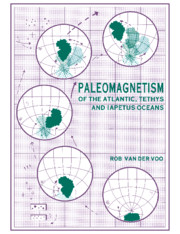Book contents
- Frontmatter
- Contents
- Preface and acknowledgements
- 1 Prologue
- 2 Paleopoles and paleomagnetic directions
- 3 Megaplates, microplates, blocks, terranes, accreted slivers, thrusts and olistostromes
- 4 Paleomagnetic information – what makes a paleopole valuable?
- 5 The major continents and Pangea
- 6 The opening of the Atlantic Ocean
- 7 The Tethys blocks
- 8 The terranes, blocks and adjacent continents of the Iapetus Ocean
- 9 Epilogue
- 10 Appendix
- References
- Index
4 - Paleomagnetic information – what makes a paleopole valuable?
Published online by Cambridge University Press: 24 November 2009
- Frontmatter
- Contents
- Preface and acknowledgements
- 1 Prologue
- 2 Paleopoles and paleomagnetic directions
- 3 Megaplates, microplates, blocks, terranes, accreted slivers, thrusts and olistostromes
- 4 Paleomagnetic information – what makes a paleopole valuable?
- 5 The major continents and Pangea
- 6 The opening of the Atlantic Ocean
- 7 The Tethys blocks
- 8 The terranes, blocks and adjacent continents of the Iapetus Ocean
- 9 Epilogue
- 10 Appendix
- References
- Index
Summary
As already mentioned, some 7000 paleopoles have been published in the last four decades. As with any discipline, there are ‘good’ and ‘bad’ data in this extensive data base. The problem is to decide which is which, and to make this decision with some degree of objectivity. It simply will not do to state that the paleopoles produced in one's own laboratory are, by definition, superior to those produced elsewhere!
In the preceding chapters, I have treated the main assumptions that underlie the calculation of a paleopole, as well as the basis for dividing the Earth's surface into smaller tectonic elements. In this chapter, I will examine the evidence and information that can (and oftentimes must) be provided to make a pole valuable or reliable, including that related to field and laboratory aspects of paleomagnetic studies.
One of the more important considerations in any geological endeavor is the determination of a geological or radiometric age. Unfortunately, paleopoles cannot be dated directly, nor have any radiogenic isotope age determination techniques been fully applied yet to the dating of magnetic minerals, such as (titano-) magnetite, (titano-) hematite, goethite or pyrrhotite. The discussion begins, therefore, with the age constraints for the rocks from which a paleopole has been derived, but at the end of this chapter I will return to the still more important matter of constraints on the age of a paleopole, in the meantime having dealt with the important experiments and tests provided by demagnetizations, folds, conglomerates, baked contacts and reversals.
- Type
- Chapter
- Information
- Publisher: Cambridge University PressPrint publication year: 1993



